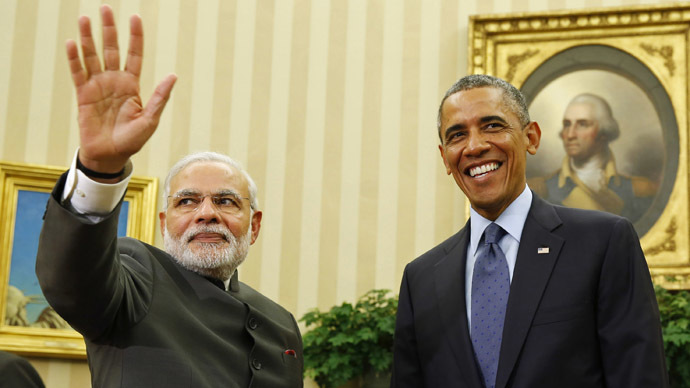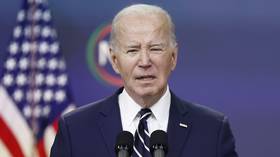Hits and misses of Indian PM Modi’s US visit

India has never been on top of Washington’s radar screens and in Asia the Americans have been more bothered about their strategic ties with Japan, Taiwan and Philippines - all because of the China factor.
There is nothing to suggest that the United States’ policies vis-a-vis India would undergo even a slightest shift after Indian Prime Minister Narendra Modi’s concluded his five-day visit to the US.
The Americans’ strategic interests have gone up substantially with regard to two other backyard countries of China – Vietnam and Myanmar. India can climb up the American ladder of interest in Asia and be on par with Japan in the American scheme of things, leaving all other Asian countries far behind.
But India is not willing to toe the American line on anything and everything, be it WTO issues or taxation and visa matters, or differences over the Intellectual Property Rights (IPR) or American policies over Russia, Afghanistan and Islamic State (IS).
More importantly, India is neither willing to dilute its relations with Russia, or criticize Russia over developments in Ukraine, or take on China to further the American interests in the region.
All these differences continued to remain even after Modi’s talks with President Obama and his top cabinet colleagues in Washington DC on September 29-30.
That’s why the American newspapers hardly mentioned Modi’s US visit on their front pages. But America came up with two rude shocks, one for Modi specifically and the other for India in general.
It must also be noted upfront that Modi’s visit to the US was a personal victory as he had been denied a US visa since 2005 for his alleged role in the 2002 Gujarat riots when he was the state’s chief minister. Ironically, he got a rock star-like reception by a crowd of over 18,000 in New York’s Madison Square Garden, the very venue which he was to visit in 2005 when the US denied him the visa.
The first red rag for Modi came even before he touched down on American soil, a federal court in New York issued summons against him in the 2002 riots case. Courts in the US have done this to Indian leaders several times in the past and former Prime Minister Manmohan Singh and Congress President Sonia Gandhi too were slapped with such provocative summons while they were in the US in the past.
Obviously, the summons against Modi are nothing more than pin-pricks as American officials themselves have made it clear that as the Prime Minister, Modi has complete immunity against such court cases in the US. However, the incident did cast a shadow over Modi’s American trip even before it began.
The second provocation, aimed this time at India as a nation, came from the American media. On September 28, The New York Times published a rather racist cartoon lampooning India’s unprecedented space success as on September 24 India became the first country in the world to send an orbiter mission to Mars at the very first attempt.
The cartoon, when Modi was still in New York, showed a poor turbaned man with a cow in tow knocking on the doors of the Elite Space Club. (India is the fourth spacefaring power in the world, after the US, Russia and Europe, to have successfully launched a Mars orbiter mission.) The cartoon shows two white men sitting inside the Elite Space Club, reading a newspaper which has India’s Mars mission success as its top headline, and looking visibly displeased by the unwelcome knock.
The American mindset comes out clearly with these two pin-pricks and shows how Americans at large view India, though there is nothing to show that the Obama administration is behind these or even shares this mindset.
New Delhi has obviously noted these two developments but is committed to taking its relations with Washington to a higher trajectory. The Americans themselves have been keen on cementing their ties with India and quintupling bilateral trade of $100 billion per annum, though they have not given any specific timeline when they hope to reach the $500 billion bilateral trade.
Narendra Modi and Barack Obama wrote a joint editorial in the Washington Post on September 30, titled “A renewed US-India partnership for the 21st century.” Consider the following paragraph from this editorial which gives a fitting response to the NYT cartoon and conveys the two governments’ position on space exploration.
“The exploration of space will continue to fire our imaginations and challenge us to raise our ambitions. That we both have satellites orbiting Mars tells its own story. The promise of a better tomorrow is not solely for Indians and Americans: It also beckons us to move forward together for a better world. This is the central premise of our defining partnership for the 21st century. Forward together we go — chalein saath saath.”
Ahead of his US visit, PM Modi wrote an Op-Ed piece in the Wall Street Journal: “India and the US have a fundamental stake in each other’s success—for the sake of our values and our many shared interests…The complementary strengths of India and the US can be used for inclusive and broad-based global development to transform lives across the world.”
While Modi succeeded in captivating the Indian Americans during the New York leg of his US trip, his Washington leg was by and large an exercise in introducing himself to Obama and his top officials. No big ticket deals were signed after the formal Modi-Obama talks.
But diplomacy is a marathon, not a 100-meter race. Through his visit, Modi has tried to put bilateral relations back on the rails after a visible chill in Indo-US relations in the past year, particularly since the humiliation of Devyani Khobragade an Indian diplomat in New York.
It will take years for India to figure prominently on the American foreign policy radar. A nation of 1.2 billion people and an economy of $1.8 trillion cannot be ignored by Washington for long, after all.
The statements, views and opinions expressed in this column are solely those of the author and do not necessarily represent those of RT.
The statements, views and opinions expressed in this column are solely those of the author and do not necessarily represent those of RT.













